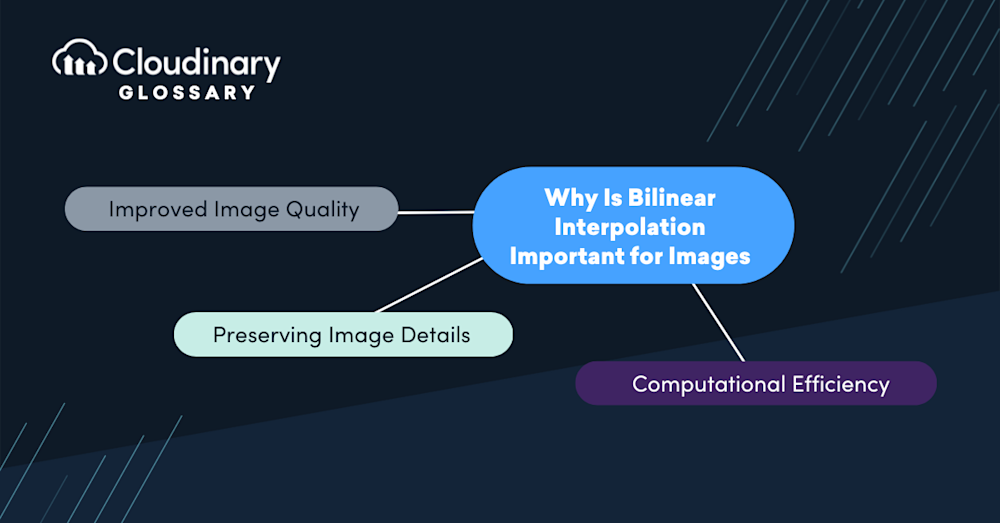What Is Bilinear Interpolation?
Bilinear interpolation is a resampling method that scales or manipulates images and grids. At its core, the technique is about estimating a new pixel value within a two-dimensional array using the four nearest pixel values, which are directly adjacent both vertically and horizontally. This method calculates the new value by performing linear interpolation first in one direction and then in the other. The ‘bi’ in bilinear indicates these two stages, making it one step up from linear interpolation, which only considers two points along a single line.
To understand bilinear interpolation, envision a mesh overlaid on an image; each intersection of the mesh is a pixel. When enlarging an image, you often face blank intersections with unknown data. Bilinear interpolation fills these gaps by considering the ‘neighborhood’ of known pixel values around the blank spot. The process involves drawing straight lines between the known values to estimate the unknown ones, factoring in the distances from the known points to keep the grand scale of the image.
This method strikes a balance between computational complexity and visual quality, providing a practically efficient way to handle images without sacrificing smoothness and detail.
Why Is Bilinear Interpolation Important for Images?
Bilinear interpolation offers significant advantages when it comes to image resizing and scaling. Some important reasons why bilinear interpolation is crucial for images include:
- Improved Image Quality: Bilinear interpolation allows for a smooth transition between pixels when resizing or scaling an image. Estimating new pixel values based on surrounding pixels reduces pixelation and aliasing artifacts, resulting in higher-quality and visually pleasing images.
- Preserving Image Details: Bilinear interpolation ensures that important image details are preserved during resizing or scaling operations. It reduces the loss of vital information and maintains the visual integrity of the original image, making it particularly useful in applications such as computer graphics and digital photography.
- Computational Efficiency: Bilinear interpolation balances computational complexity and image quality. It provides a good compromise between accuracy and computational efficiency, making it suitable for real-time image processing applications where performance is crucial.
How Does Bilinear Interpolation Work?
Here’s a step-by-step look at how bilinear interpolation calculates the value of a new pixel-based on the values of surrounding pixels:
- Locate the Four Closest Pixels – The process begins by locating the four nearest known pixel values surrounding the target pixel. These are typically referred to as the top-left, top-right, bottom-left, and bottom-right pixels.
- Horizontal Interpolation – Next, two linear interpolations are performed along the horizontal axis. This means that we interpolate values between the top two pixels and between the bottom two pixels, creating two temporary pixel values.
- Vertical Interpolation – With two interpolated horizontal pixel values, a final linear interpolation is conducted along the vertical axis. This merges the two temporary values based on their vertical proximity to the desired pixel location.
By blending the intensities of these adjacent pixels in such a manner, bilinear interpolation effectively smooths out the transition between pixel values, leading to a more naturally appearing image when viewed at varied resolutions.
Use Cases of Bilinear Interpolation
Bilinear interpolation finds application in various areas where image resizing and scaling are required. Some common use cases include:
- Image Resizing – Bilinear interpolation is commonly used in image resizing operations. When scaling an image up or down, bilinear interpolation helps generate new pixel values based on the surrounding pixels, resulting in a smoother and more visually appealing resized image.
- Zooming and Pan Techniques – Bilinear interpolation is used in techniques such as zooming or panning within an image. It enables smooth transitions and continuous scaling, allowing users to explore specific regions of an image with enhanced detail and minimal distortion.
- Computer Graphics – Bilinear interpolation is widely used in computer graphics for texture mapping, where textures need to be stretched or compressed to fit onto 3D models or surfaces. It ensures that the textures appear natural and realistic by smoothly interpolating pixel values.
- Digital Photography – Bilinear interpolation is used in digital cameras and image processing software for tasks such as image resizing and displaying preview images. It helps maintain image quality and preserves details while resizing images for different display sizes or aspect ratios.
Final Thoughts
Bilinear interpolation is a powerful technique that plays a crucial role in image resizing and scaling operations. By estimating new pixel values based on neighboring pixels, it enhances image quality, preserves important details, and reduces artifacts. Whether in image resizing, zooming, computer graphics, or digital photography; bilinear interpolation is essential for delivering visually appealing, high-quality images. Incorporating bilinear interpolation in image processing workflows allows for improved image manipulation and ensures a better user experience in various applications.
Unlock the full potential of your digital content with Cloudinary’s advanced editing and optimization tools. Sign up for free today!
Additional Resources You May Find Useful:





